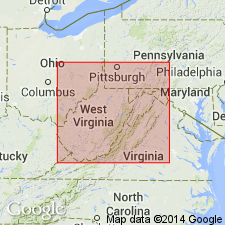
- Usage in publication:
-
- Rowlesburg Formation
- Modifications:
-
- Named
- Dominant lithology:
-
- Shale
- Mudstone
- AAPG geologic province:
-
- Appalachian basin
Summary:
Rowlesburg Formation is here named and described from an outcrop near Rowlesburg, Preston Co, and assigned to the base of the Hampshire Group (rank raised). A reference section is designated along Rte 72, midway between Hannahsville and St. George. In subsurface, unit consists of a sandstone-poor, red shale and mudstone-rich interval. Lower contact is placed at the base of the red shale sequence which overlies the newly named Cannon Hill Formation, basal unit of the Hampshire Group. The Rowlesburg grades upward into the Oswayo Member of the Price Formation, and as it thins westward, grades rapidly into the massive sandstones of the Venango Formation. Unit is divided at type into the informal "Bayard", "Fifth", "Fourth", and "Gordon" intervals, which closely correspond to the drillers' units. It also includes equivalents of the lower part of the "Thirty-foot" sandstone, but because this interval straddles the formational boundary, it is not useful for subsurface study and is not recognized in this report. Because the Rowlesburg becomes younger westward, these chronostratigraphic intervals are found in the Cannon Hill or Greenland Gap Formations to the west. Thickness ranges from 530 ft (162 m) at Rowlesburg to 150 ft (46 m) in eastern Harrison Co. Age is Late Devonian.
Source: GNU records (USGS DDS-6; Reston GNULEX).
For more information, please contact Nancy Stamm, Geologic Names Committee Secretary.
Asterisk (*) indicates published by U.S. Geological Survey authors.
"No current usage" (†) implies that a name has been abandoned or has fallen into disuse. Former usage and, if known, replacement name given in parentheses ( ).
Slash (/) indicates name conflicts with nomenclatural guidelines (CSN, 1933; ACSN, 1961, 1970; NACSN, 1983, 2005, 2021). May be explained within brackets ([ ]).

